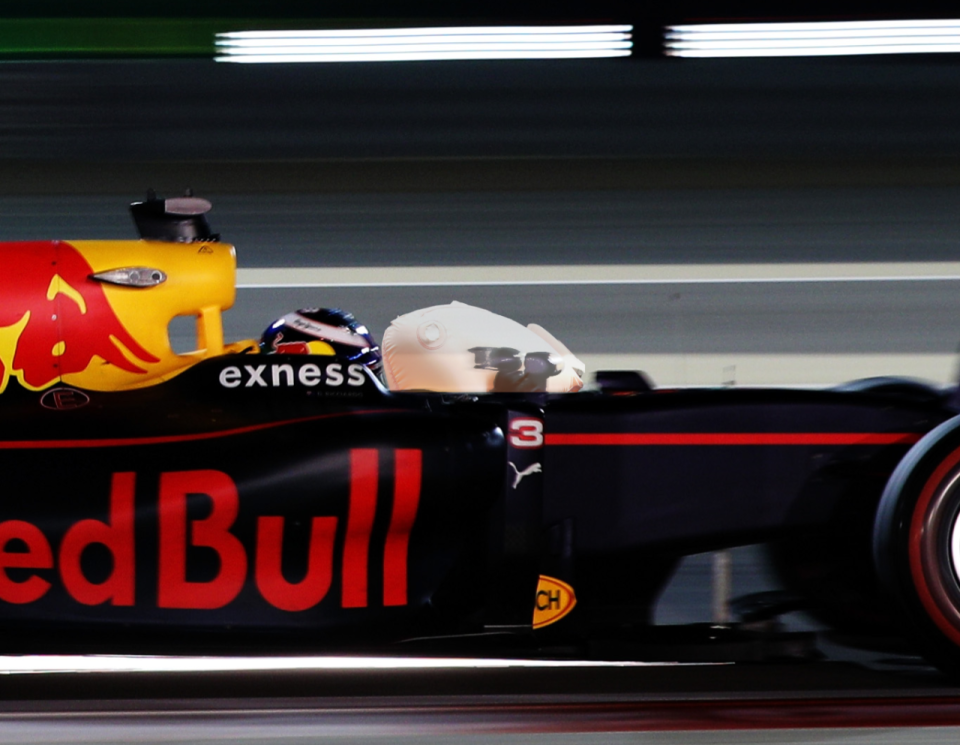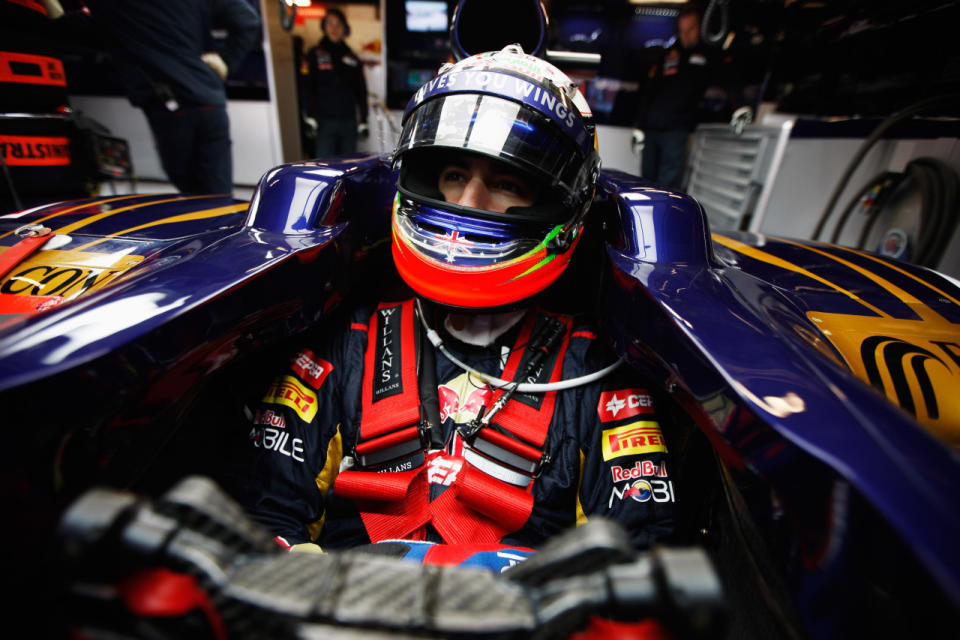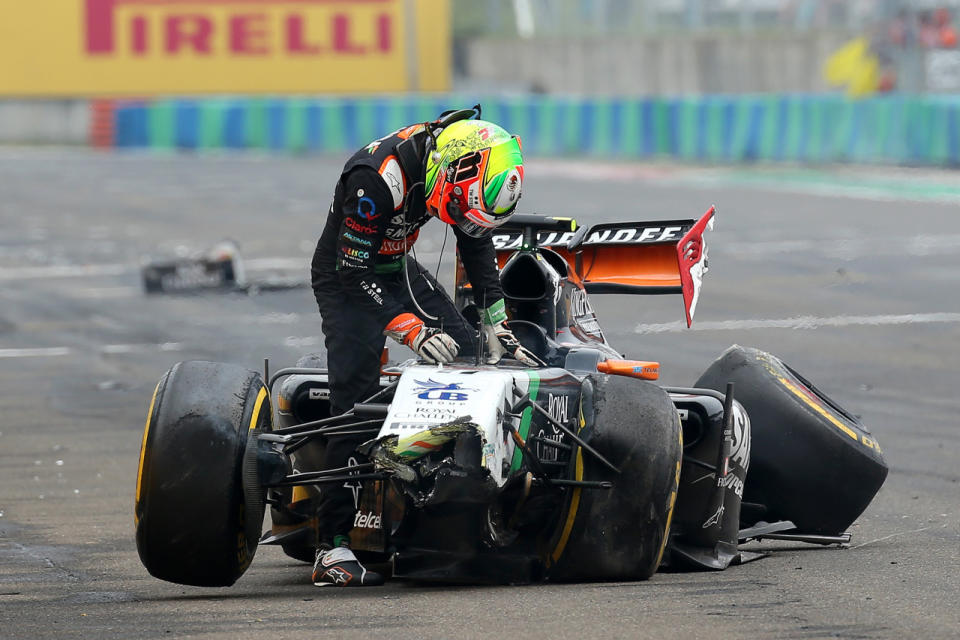Why don’t F1 cars have airbags?

All the cars on our roads are fitted with airbags. In fact, modern cars are fitted with lots of airbags, as many as ten being dotted around the passenger cabin.
There are airbags to protect your face, your knees, the side of your torso… the list goes on.
But in F1 (and other motorsports), these ubiquitous safety devices are absent. If they are such a great idea, why aren’t they fitted to racers (pictured… of course, the photo is a mock-up) which, let’s face it, are more likely to crash and at higher speeds?
What’s an airbag?

The airbag in your car’s steering wheel is simply a nylon bag which inflates when sensors detect that a significant collision has taken place (equivalent to hitting a wall at around 10-15mph).
A blast of hot nitrogen gas is produced by combining chemicals such as sodium azide (which is deeply unpleasant stuff if you mix it with water, let it touch metal or are unfortunate enough to inhale it… other chemicals are available) and potassium nitrate, and the bag inflates to about 5psi in 20-30 milliseconds.
It’s not unlike a rocket booster, and the bag comes towards your face at about 200mph. That’s why it can be a bit painful, though considerably less painful than a face-full of steering wheel.
Why an airbag would be useless in F1

A steering wheel or dash-mounted airbag is designed to decelerate your body (relatively) gradually and stop it cannoning into whatever is behind the bag.
An F1 driver is already strapped in so tightly that there is no danger of them being slammed into the steering column.
There was a danger that a driver’s unrestrained head would snap forward in a crash, causing a potentially fatal basilar skull fracture, but the introduction of the HANS (Head And Neck Support) device in 2003 minimised that risk too.
Without seat harnesses, not only would driving an F1 car be more dangerous, it would be near impossible – these cars can pull 5g under braking and, without the belts, drivers would be scrunched up against the steering wheel at the first corner.
F1 seatbelts are six-point units which have to withstand forces up to 1.5tonnes in an impact; in fact, drivers have survived peak decelerations of 75g in the last decade, meaning the seatbelts were holding back a man who effectively weighed five tonnes.
Those harnesses are made of lightweight military grade polyester and titanium, and they are very strong indeed.
Why an airbag would be dangerous in F1

The airbag sensors in a road-going car are quite complex – an accelerometer will tell the airbag’s digital brain that an impact is taking place. The microprocessor will take readings from several accelerometers and pressure sensors, and compare them against pre-programmed parameters, before deciding whether to send an activation signal to the airbag.
All this can take place less than 10milliseconds after an impact begins.
The trouble with F1 cars is that they take a lot of punishment, and the risk of an airbag being triggered accidentally is huge. Think of the consequences of an airbag going off in Lewis Hamilton’s face as he hits a kerb hard at 150mph.
Even after it deflates, there’s still an empty nylon bag flapping around to obscure his vision and, potentially, create a fire hazard.
What about airbags around the car?

An F1 car’s safety comes from its immensely strong carbon-fibre monocoque, coupled with crumple zones around the cockpit.
These crumple zones do a similar job to airbags – absorbing kinetic energy and slowing the rate of deceleration – but better, much better.
And, while a crumple zone can still function as part of the car structure, an airbag is just another bit of weight that will shave a fraction off car performance.
Has anyone actually tried to develop an F1 airbag?

Back in 1996, a project was launched to find a driver restraint system that would improve crash survivability in head-on and oblique collisions.
Both HANS (pictured) and airbag solutions were looked at, with a HANS system developed by Mercedes-Benz, McLaren and motorsport bosses at the FIA being deemed the preferred solution, in 2000.
The FIA concluded that HANS – based on a concept developed by Dr Robert Hubbard of Michigan University – was particularly effective at protecting a driver.
Because F1 drivers sit almost horizontally, an airbag will not cushion the head and chest simultaneously, which is the case in a road car. In an F1 car, the research suggested impact forces would be transmitted mainly to the chin area with an airbag, but be spread evenly across the forehead with a HANS device.
Airbags, then, can save lives when used correctly and in the right environment. Bur an F1 car is very definitely not the right environment.

